A000047 Arduino, A000047 Datasheet - Page 136

A000047
Manufacturer Part Number
A000047
Description
MCU, MPU & DSP Development Tools Mega2560
Manufacturer
Arduino
Series
-r
Type
MCUr
Specifications of A000047
Processor To Be Evaluated
ATmega2560
Interface Type
USB, I2C, SPI
Dimensions
4 in x 2.1 in
Operating Supply Voltage
5 V
Contents
Board
Lead Free Status / RoHS Status
Lead free / RoHS Compliant
For Use With/related Products
ATmega2560
- Current page: 136 of 444
- Download datasheet (10Mb)
16. 16-bit Timer/Counter (Timer/Counter 1, 3, 4, and 5)
16.1
16.2
2549M–AVR–09/10
Features
Overview
•
•
•
•
•
•
•
•
•
•
•
The 16-bit Timer/Counter unit allows accurate program execution timing (event management),
wave generation, and signal timing measurement.
Most register and bit references in this section are written in general form. A lower case “n”
replaces the Timer/Counter number, and a lower case “x” replaces the Output Compare unit
channel. However, when using the register or bit defines in a program, the precise form must be
used, that is, TCNT1 for accessing Timer/Counter1 counter value and so on.
A simplified block diagram of the 16-bit Timer/Counter is shown in
the actual placement of I/O pins, see
“Pinout ATmega1281/2561” on page
pins, are shown in bold. The device-specific I/O Register and bit locations are listed in the
ister Description” on page
The Power Reduction Timer/Counter1 bit, PRTIM1, in
page 56
The Power Reduction Timer/Counter3 bit, PRTIM3, in
page 57
The Power Reduction Timer/Counter4 bit, PRTIM4, in
page 57
The Power Reduction Timer/Counter5 bit, PRTIM5, in
page 57
Timer/Counter4 and Timer/Counter5 only have full functionality in the ATmega640/1280/2560.
Input capture and output compare are not available in the ATmega1281/2561.
True 16-bit Design (that is, allows 16-bit PWM)
Three independent Output Compare Units
Double Buffered Output Compare Registers
One Input Capture Unit
Input Capture Noise Canceler
Clear Timer on Compare Match (Auto Reload)
Glitch-free, Phase Correct Pulse Width Modulator (PWM)
Variable PWM Period
Frequency Generator
External Event Counter
Twenty independent interrupt sources (TOV1, OCF1A, OCF1B, OCF1C, ICF1, TOV3, OCF3A,
OCF3B, OCF3C, ICF3, TOV4, OCF4A, OCF4B, OCF4C, ICF4, TOV5, OCF5A, OCF5B, OCF5C and
ICF5)
must be written to zero to enable Timer/Counter1 module.
must be written to zero to enable Timer/Counter3 module.
must be written to zero to enable Timer/Counter4 module.
must be written to zero to enable Timer/Counter5 module.
158.
ATmega640/1280/1281/2560/2561
4. CPU accessible I/O Registers, including I/O bits and I/O
“TQFP-pinout ATmega640/1280/2560” on page 2
“PRR0 – Power Reduction Register 0” on
“PRR1 – Power Reduction Register 1” on
“PRR1 – Power Reduction Register 1” on
“PRR1 – Power Reduction Register 1” on
Figure 16-1 on page
137. For
“Reg-
and
136
Related parts for A000047
Image
Part Number
Description
Manufacturer
Datasheet
Request
R

Part Number:
Description:
Daughter Cards & OEM Boards ARDUINO UNO PROTO PCB REV 3
Manufacturer:
Arduino

Part Number:
Description:
Daughter Cards & OEM Boards ARDUINO SHIELD PROTO KIT REV 3
Manufacturer:
Arduino

Part Number:
Description:
Daughter Cards & OEM Boards ARDUINO MEGA PROTO KIT REV 3
Manufacturer:
Arduino

Part Number:
Description:
Daughter Cards & OEM Boards ARDUINO MEGA PROTO PCB REV 3
Manufacturer:
Arduino

Part Number:
Description:
Development Boards & Kits - AVR ARDUINO STARTER KIT W/ UNO REV3
Manufacturer:
Arduino

Part Number:
Description:
RF Development Tools ARDUINO SHIELD WIRELESS PROTO
Manufacturer:
Arduino
Datasheet:

Part Number:
Description:
RF Development Tools ARDUINO SHIELD WIRELESS WITH SD
Manufacturer:
Arduino
Datasheet:

Part Number:
Description:
Development Software Getting started w/Arduino
Manufacturer:
Arduino

Part Number:
Description:
Ethernet Modules & Development Tools Ethernet Shield for Arduino
Manufacturer:
Arduino

Part Number:
Description:
MCU, MPU & DSP Development Tools LilyPad Arduino Main Board
Manufacturer:
Arduino

Part Number:
Description:
ARDUINO NANO Board
Manufacturer:
Arduino
Datasheet:

Part Number:
Description:
Ethernet Modules & Development Tools ETHERNET SHEILD PoE FOR ARDUINO
Manufacturer:
Arduino
Datasheet:

Part Number:
Description:
ATMEGA328 MCU IC W/ Arduino UNO Bootloader
Manufacturer:
Arduino
Datasheet:

Part Number:
Description:
Memory Cards MICRO SD CARD 1GB WITH SD ADAPTER
Manufacturer:
Arduino










